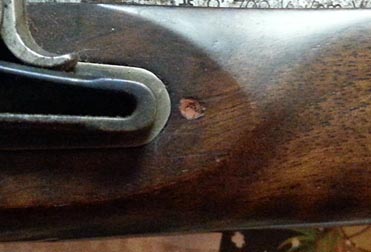Just bought a Traditions 50 cal Kentucky flintlock and it shoots great but I do have one issue. When seating the ramrod it will not go all the way in because it hits the front sidelock screw. When I remove the screw the rod goes all the way in and I feel it being seated into some kind of bushing that I assume gives the rod the snug fit so it won't bounce forward when discharged. My temporary remedy was to notch the ramrod so the screw can be seated into the sidelock so I can shoot it, as seen in the first photo, but the rod will not come out without removing the screw. I use a range rod anyway but I do want to fix this issue.
1...Should I take off the front stock to get to the channel and for repairs and what about the bushing to make the rod snug? How does it get removed or repaired or exactly what do I do? Is it worth all this to fix it or shall I just put the rod in, screw the screw in and never remove the rod again??????
2... In the second picture I took of the trigger guard off and discovered 2 screws in the stock. One at the very rear and the other at the front. What are these for?
Thanks for your help?
1...Should I take off the front stock to get to the channel and for repairs and what about the bushing to make the rod snug? How does it get removed or repaired or exactly what do I do? Is it worth all this to fix it or shall I just put the rod in, screw the screw in and never remove the rod again??????
2... In the second picture I took of the trigger guard off and discovered 2 screws in the stock. One at the very rear and the other at the front. What are these for?
Thanks for your help?








